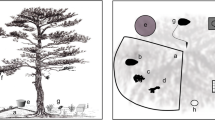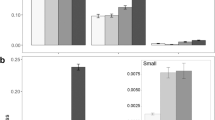Abstract
We investigated the role of seed predation by rodents in the recruitment of the fleshy-fruited trees Taxus baccata, Ilex aquifolium and Crataegus monogyna in temperate secondary forests in NW Spain. We measured the densities of dispersed seeds, early emerged seedlings, established recruits and adults, at four sites over a period of 2 years. Seed predation among species was compared by seed removal experiments and analysis of rodent larder-hoards. The three species differed markedly in local regeneration patterns. The rank order in the seed rain following decreasing seed density was Ilex, Taxus and Crataegus. However, Crataegus established 3.3 times more seedlings than Taxus. For all species, there was a positive linear relationship between the density of emerged seedlings and seed density, suggesting that recruitment was seed- rather than microsite-limited. A consistent pattern of seed selection among species was exerted by rodents, which preferred Taxus and, secondarily, Ilex seeds to Crataegus seeds. Predation ranking was the inverse of that of seed protection against predators, measured as the mass of woody coat per mass unit of the edible fraction. Recruitment potential, evaluated as the ratio of seedlings to seeds, was negatively related to seed predation, with the rank order Crataegus > Ilex > Taxus. The selective early recruitment limitation exerted by predation may have a demographic effect in the long term, as judged by the positive relationship between early seedling emergence and the density of established recruits. By modulating the pre-emptive competition for seed safe sites, rodents may preclude the progressive exclusion of species that produce low numbers of seeds (i.e. Crataegus) by those dominant in seed number (i.e. Ilex, Taxus), or at least foster the evenness for site occupation among seedlings of different species.




Similar content being viewed by others
References
Alcántara JM, Rey PJ, Valera F, Sánchez-Lafuente AM (2000a) Factors shaping the seedfall pattern of a bird-dispersed plant. Ecology 11:1937–1950
Alcántara JM, Rey PJ, Sánchez-Lafuente AM, Valera F (2000b) Early effects of rodent post-dispersal seed predation on the outcome of the plant-seed disperser interaction. Oikos 88:362–370
Andersen AN (1989) How important is seed predation to recruitment in stable populations of long-lived perennials? Oecologia 81:310–315
Arrieta S, Suárez F (2004) Germination and seed bank depletion of holly (Ilex aquifolium L.) in four microhabitats types. Seed Sci Res 14:305–313
Barnea A, Harborne JB, Pannell C (1993) What parts of fleshy fruits contain secondary compounds toxic to birds and why?. Biochem Syst Ecol 21:421–429
Blate GM, Peart DR, Leighton M (1998) Post-dispersal predation on isolated seeds: a comparative study of 40 tree species in a Southeast Asian rainforest. Oikos 82:522–538
Brown JH, Heske EJ (1990) Control of a desert-grassland transition by a keystone rodent guild. Science 250:1705–1707
Clark JS, Macklin E, Wood L (1998) Stages and spatial scales of recruitment limitation in southern Appalachian forests. Ecol Monogr 68:213–235
Clarke PJ, Kerrigan RA (2002) The effects of seed predators on the recruitment of mangroves. J Ecol 90:728–736
Crawley MJ (1992) Seed predators and plant population dynamics. In: Fenner M (ed) Seeds: the ecology of regeneration in plant communities. CABI, London, pp 157–191
Crawley MJ (1993) GLIM for ecologists. Blackwell, Oxford
Crawley MJ, Long CR (1995) Alternate bearing, predator satiation and seedling recruitment in Quercus robur L. J Ecol 83:683–696
De Steven D (1991a) Experiments on mechanisms of tree establishment in old-field succession: seedling emergence. Ecology 72:1066–1075
De Steven D (1991b) Experiments on mechanisms of tree establishment in old-field succession: seedling survival and growth. Ecology 72:1076–1088
De Steven D, Wright SJ (2002) Consequences of variable reproduction for seedling recruitment in three neotropical tree species. Ecology 83:2315–2327
Edwards GR, Crawley MJ (1999) Rodent seed predation and seedling recruitment in mesic grasslands. Oecologia 118:288–296
Eriksson O, Ehrlén J (1992) Seed and microsite limitation in plant populations. Oecologia 91:360–364
García D, Obeso JR (2003) Facilitation by herbivore-mediated nurse plants in a threatened tree Taxus baccata: local effects and landscape level consistency. Ecography 26:739–750
García D, Obeso JR, Martínez I (2005) Spatial concordance between seed rain and seedling establishment in bird-dispersed trees: does scale matter? J Ecol 93:000–000
Greenwood JJD (1985) Frequency-dependent selection by seed-predators. Oikos 44:195–210
Grubb PJ, Lee WG, Kollmann J, Wilson JB (1996) Interaction of irradiance and soil nutrient supply on growth of seedlings on ten European tall-shrub species and Fagus sylvatica. J Ecol 84:827–840
Grubb PJ, Metcalfe DJ, Grubb EAA, Jones GD (1998) Nitrogen-richness and protection of seeds in Australian tropical rain forest: a test of plant defence theory. Oikos 82:467–482
Hansson L (1985) The food of bank voles, wood mice and yellow-necked mice. Symp zool Soc Lond 55:141–168
Harms KE, Wright SJ, Calderón O, Hernández A, Herre EA (2000) Pervasive density-dependent recruitment enhances seedling diversity in a tropical forest. Nature 404:493–495
Herrera CM, Jordano P, López-Soria L, Amat JA (1994) Recruitment of a mast-fruiting, bird-dispersed tree: bridging frugivore activity and seedling establishment. Ecol Monogr 64:315–344
Herrera CM, Jordano P, Guitián J, Traveset A (1998) Annual variability in seed production by woody plants and the masting concept: reassessment of principles and relationship to pollination and seed dispersal. Amer Nat 152:576–594
Hofmann LA, Redente EF, McEwen LC (1995) Effects of selective seed predation by rodents on shortgrass establishment. Ecol Appl 5:200–208
Howe HF, Brown JS (1999) Effects of birds and rodents on synthetic tallgrass communities. Ecology 80:1776–1781
Hubbell SP, Foster RB, O’Brien ST, Harms KE, Condit R, Weschler B, Wright SJ, Loo de Lao S (1999) Light gap disturbance, recruitment limitation, and tree diversity in a neotropical forest. Science 283:554–557
Hulme PE (1993) Post-dispersal seed predation by small mammals. Symp zool Soc Lond 65:269–287
Hulme PE (1994) Post-dispersal seed predation in grassland: its magnitude and sources of variation. J Ecol 82:645–652
Hulme PE (1996a) Natural regeneration of yew (Taxus baccata L.): microsite, seed or herbivore limitation? J Ecol 84:853–861
Hulme PE (1996b) Herbivory, plant regeneration, and species coexistence. J Ecol 84:609–615
Hulme PE (1997) Postdispersal seed predation and the establishment of vertebrate dispersed plants in Mediterranean scrublands. Oecologia 111:91–98
Hulme PE (1998) Post-dispersal seed predation: consequences for plant demography and evolution. Perspect Plant Ecol Evol Syst 1:46–60
Hulme PE, Borelli T (1999) Variability in post-dispersal seed predation in deciduous woodland: relative importance of location, seed species, burial and density. Plant Ecol 145:149–156
Hulme PE and Hunt MK (1999) Rodent post-dispersal seed predation in deciduous woodland: predator response to absolute and relative abundance of prey. J Anim Ecol 68:417–428
Hurtt GC, Pacala SW (1995) The consequences of recruitment limitation: reconciling chance, history and competitive differences between plants. J Theor Biol 176:1–12
Janzen DH (1971) Seed predation by animals. Annu Rev Ecol Syst 2:465–492
Kerley GIH, Erasmus T (1991) What do mice select for in seeds?. Oecologia 86:261–267
Kollmann J (1995) Regeneration window for fleshy-fruited plants during scrub development on abandoned grassland. Écoscience 2:213–222
Kollmann J (2000) Dispersal of fleshy-fruited species: a matter of spatial scale? Perspect Plant Ecol Evol Syst 3:29–51
Kollmann J, Pirl M (1995) Spatial pattern of seed rain of fleshy-fruited plants in a scrubland-grassland transition. Acta Oecol 16:313–329
Kollmann J, Reiner SA (1996) Light demands of shrub seedlings and their establishment within scrublands. Flora 191:191–200
Kollmann J, Coomes DA, White SM (1998) Consistencies in post-dispersal seed predation of temperate fleshy-fruited species among seasons, years and sites. Funct Ecol 12:683–690
Manson RH, Stiles EW (1998) Links between microhabitat preferences and seed predation by small mammals in old fields. Oikos 82:37–50
Maron JL, Simms EL (1997) Effect of seed predation on seed bank size and seedling recruitment of bush lupine (Lupinus arboreus). Oecologia 111:76–83
Martínez I (2004) Dinámica de transferencia de semillas en una comunidad de plantas ornitócoras. Seminario de Investigación. Universidad de Oviedo, Oviedo
Moles AT, Warton DI, Westoby M (2003) Do small-seeded species have higher survival through seed predation than large-seeded species?. Ecology 84:3148–3161
Müller-Landau HC, Wright SJ, Calderón O, Hubbell SP, Foster RB (2002) Assessing recruitment limitation: concepts, methods and case-studies from a tropical forest. In: Levey DJ, Silva WR, Galetti M (eds) Seed dispersal and frugivory, evolution and conservation. CABI, New York, pp 35–52
Myster RW, Pickett STA (1993) Effects of litter, distance, density and vegetation patch type on postdispersal tree seed predation in old fields. Oikos 66:381–388
Obeso JR (1998) Patterns of variation in Ilex aquifolium fruit traits related to fruit consumption by birds and seed predation by rodents. Écoscience 5:463–469
Obeso JR, Fernández-Calvo I (2002) Fruit removal, pyrene dispersal, post-dispersal predation and seedling establishment of a bird-dispersed tree. Plant Ecol 165:223–233
Peterken GF, Lloyd PS (1967) Ilex aquifolium L. Biological flora of the British Isles. J Ecol 55:841–858
Reader RJ (1993) Control of seedling emergence by ground cover and seed predation in relation to seed size for some old-field species. J Ecol 81:169–175
Reader RJ (1997) Potential effects of granivores on old field succession. Can J Bot 75:2224–2227
Rey PJ, Garrido JL, Alcántara JM, Ramírez JM, Aguilera A, García L, Manzaneda AJ, Fernández R (2002) Spatial variation in ant and rodent post-dispersal predation of vertebrate dispersed seeds. Funct Ecol 16:773–781
Sallabanks R (1992) Fruit fate, frugivory, and fruit characteristics: a study of the hawthorn, Crataegus monogyna (Rosaceae). Oecologia 91:296–304
Schupp EW, Milleron T, Russo S (2002) Dissemination limitation and the origin and maintenance of species-rich tropical forests. In: Levey DJ, Silva WR, Galetti M (eds) Seed dispersal and frugivory, evolution and conservation. CABI, New York, pp 19–33
Snow B, Snow D (1988) Birds and berries. T and AD Poyser, Calton
Thomas PA, Polwart A (2003) Taxus baccata L. J Ecol 91:489–524
Turnbull LA, Crawley MJ, Rees M (2000) Are plant populations seed-limited? A review of seed sowing experiments. Oikos 88:225–238
Whelan CJ, Willson MF, Tuma CA, Souza-Pinto I (1991) Spatial and temporal patterns of postdispersal seed predation. Can J Bot 69:428–436
Wright SJ (2002) Plant diversity in tropical forests: a review of mechanisms of species coexistence. Oecologia 130:4–14
Zar JH (1996) Biostatistical analysis, 3rd edn. Prentice Hall, New Jersey
Acknowledgements
The comments made by Christian Körner and four anonymous referees greatly improved previous drafts of the manuscript. Susana García and Cristina Galán helped during the fieldwork. We thank Esteban Cabal for lab assistance. Christine Francis checked the English. We also acknowledge a contract from the Programme “Ramón y Cajal” (MCYT) awarded to DG, a PFPU grant (MEC) to IM, and the projects CGL2004-2936 (MEC) and BIOCON03-162 (Fundación BBVA) to DG.
Author information
Authors and Affiliations
Corresponding author
Additional information
Communicated by Christian Koerner
Rights and permissions
About this article
Cite this article
García, D., Obeso, J.R. & Martínez, I. Rodent seed predation promotes differential recruitment among bird-dispersed trees in temperate secondary forests. Oecologia 144, 435–446 (2005). https://doi.org/10.1007/s00442-005-0103-7
Received:
Accepted:
Published:
Issue Date:
DOI: https://doi.org/10.1007/s00442-005-0103-7




